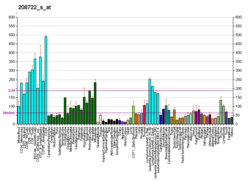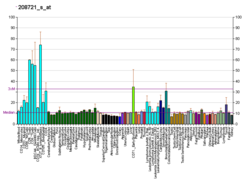From Wikipedia, the free encyclopedia
Anaphase-promoting complex subunit 5 is an enzyme that in humans is encoded by the ANAPC5 gene .[ 5] [ 6]
Template:PBB Summary
Interactions
ANAPC5 has been shown to interact with ANAPC1 ,[ 7] [ 8] ANAPC4 ,[ 7] CDC27 [ 7] [ 9] [ 10] PABPC1 .[ 9]
References
^ a b c GRCh38: Ensembl release 89: ENSG00000089053 – Ensembl , May 2017^ a b c GRCm38: Ensembl release 89: ENSMUSG00000029472 – Ensembl , May 2017^ "Human PubMed Reference:" . National Center for Biotechnology Information, U.S. National Library of Medicine .^ "Mouse PubMed Reference:" . National Center for Biotechnology Information, U.S. National Library of Medicine .^ Yu H, Peters JM, King RW, Page AM, Hieter P, Kirschner MW (March 1998). "Identification of a cullin homology region in a subunit of the anaphase-promoting complex". Science . 279 (5354): 1219–22. doi :10.1126/science.279.5354.1219 . PMID 9469815 . ^ "Entrez Gene: ANAPC5 anaphase promoting complex subunit 5" .^ a b c Vodermaier, Hartmut C; Gieffers, Christian; Maurer-Stroh, Sebastian; Eisenhaber, Frank; Peters, Jan-Michael (September 2003). "TPR subunits of the anaphase-promoting complex mediate binding to the activator protein CDH1". Curr. Biol . 13 (17). England: 1459–68. doi :10.1016/S0960-9822(03)00581-5 . ISSN 0960-9822 . PMID 12956947 . ^ Sumara, I; Vorlaufer E; Gieffers C; Peters B H; Peters J M (November 2000). "Characterization of Vertebrate Cohesin Complexes and Their Regulation in Prophase" . J. Cell Biol . 151 (4). UNITED STATES: 749–62. doi :10.1083/jcb.151.4.749 . ISSN 0021-9525 . PMC 2169443 PMID 11076961 . ^ a b Koloteva-Levine, Nadejda; Pinchasi, Dalia; Pereman, Idan; Zur, Amit; Brandeis, Michael; Elroy-Stein, Orna (May 2004). "The Apc5 Subunit of the Anaphase-Promoting Complex/Cyclosome Interacts with Poly(A) Binding Protein and Represses Internal Ribosome Entry Site-Mediated Translation" . Mol. Cell. Biol . 24 (9). United States: 3577–87. doi :10.1128/MCB.24.9.3577-3587.2004 . ISSN 0270-7306 . PMC 387753 PMID 15082755 . ^ Gmachl, M; Gieffers C; Podtelejnikov A V; Mann M; Peters J M (August 2000). "The RING-H2 finger protein APC11 and the E2 enzyme UBC4 are sufficient to ubiquitinate substrates of the anaphase-promoting complex" . Proc. Natl. Acad. Sci. U.S.A. 97 (16). UNITED STATES: 8973–8. doi :10.1073/pnas.97.16.8973 . ISSN 0027-8424 . PMC 16806 PMID 10922056 .
Further reading
Template:PBB Controls







